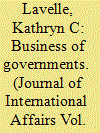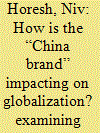| Srl | Item |
| 1 |
ID:
085703


|
|
|
| 2 |
ID:
124564


|
|
|
|
|
| Publication |
2013.
|
| Summary/Abstract |
We empirically analyze the host-country determinants of Chinese outward direct investments (ODI) in the period from 2003 to 2008, using disaggregated data by country and sector and distinguishing between state-owned or controlled enterprises (SOEs) and privately-owned firms. Our results show that the pattern of Chinese ODI differs according to corporate ownership. Private firms are attracted by large markets and host-country strategic assets and are averse to economic and political risks when choosing investment locations abroad. Differently, state-owned or controlled enterprises follow the strategic needs of their home country and invest more in natural resource sectors, being largely indifferent to the political and economic conditions in the host countries.
|
|
|
|
|
|
|
|
|
|
|
|
|
|
|
|
| 3 |
ID:
172561


|
|
|
|
|
| Summary/Abstract |
This article is aimed at better understanding China's Overseas Foreign Direct Investment (OFDI) choices through a post-War Japanese historical perspective. It will focus in the main on OFDI as a marker of an advanced stage of the East Asian ‘developmental state’ formula, wherein the ‘China Brand’ takes shape. The transition process from heavy-industry and low-value added goods to frontier-technology manufacturing with global brand recognition will be placed under scrutiny. A Japanese perspective is called for, as much of the theory in the field of international business to do with OFDI and the growth of multinational corporations (MNCs) is currently primarily derived from a Western developed-economy setting, and hence does not seek to offer much in the way of predictive insight about all-important yet middle-income China, as it proceeds towards becoming the largest economy on the planet. The article surveys the historical trajectory of Chinese OFDI, underling its correlation with inbound foreign investment into China; it then offers a comparative view of Japanese OFDI in the pre- and post-War era. It then assesses Chinese brand strength in the electrical appliance, automobile, and IT areas. Finally, it offers a prognosis as to the future direction of Chinese OFDI, and how it might affect the contours of globalization as well as Sino-American rivalries.
|
|
|
|
|
|
|
|
|
|
|
|
|
|
|
|
| 4 |
ID:
127646


|
|
|
|
|
| Publication |
2013.
|
| Summary/Abstract |
Through two illustrative case studies of enterprise reform in Henan Province, we examine the underlying political contentions behind the changing roles of local government in the process of the corporatization and asset restructuring of state-owned enterprises (SOE) starting in the late 1990s. As SOEs lose their ability to meet the multitude of resource demands from central and local officials, they become sites of inter-governmental conflicts that produce a no-win situation for the SOE and fiscal and social uncertainties for those communities trying to exit the socialist economy. Our first case study is Puyang municipal government, which leveraged its regulatory authority to exact heavy side-payments in return for not obstructing the corporatization of Zhongyuan Oilfield; the second case involves Zhengzhou city officials colluding with provincial bureaucrats and the state-appointed managers of the Yutong Bus Company in an insider privatization that effectively circumvented a specific Ministry of Finance prohibition.
|
|
|
|
|
|
|
|
|
|
|
|
|
|
|
|
| 5 |
ID:
112918


|
|
|
|
|
| Publication |
2012.
|
| Summary/Abstract |
Oil prices in 2008-10, measured in constant money, were almost eight times the level of 1970-72. The prices of minerals and metals, another exhaustible resource group, increased by a mere 45% in the same period. The paper contends that the actions of OPEC, primarily production quotas, cannot account for this stark difference in price performance. Neither can the evolution of oil prices be rationalized by cost developments, for costs have remained far below the prices. The price evolution is better explained by capacity constraints caused by the inefficiency of state owned enterprises that dominate the oil industry since the 1970s, and that, additionally, have been deprived by their owners of financial resources to invest in capacity maintenance and growth. A capacity-destroying "resource curse" afflicting many oil producing nations, has been a further factor driving prices upwards.
|
|
|
|
|
|
|
|
|
|
|
|
|
|
|
|